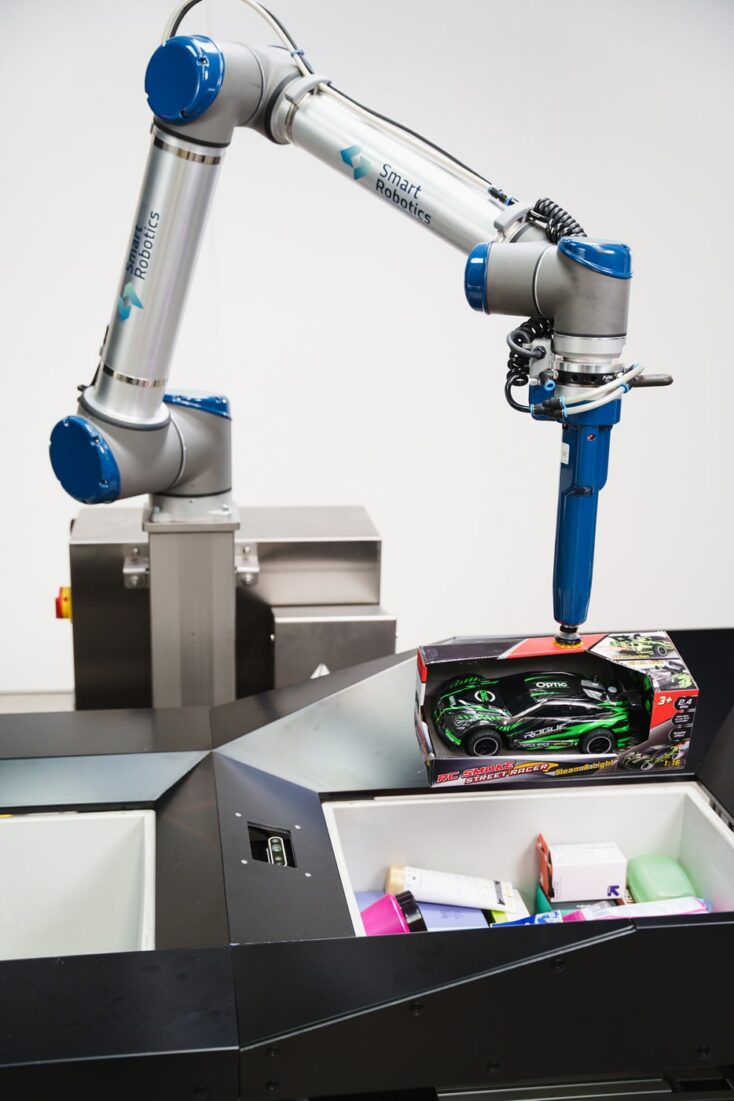Table of contents
Get in touch with our team

This site is protected by reCAPTCHA and the Google Privacy Policy and Terms of Service apply.

Smart Task Planning to improve robot efficiency
Table of contents
To ensure reliable operation of our pick & place solutions, we have developed the Technology Trinity at Smart Robotics. The Technology Trinity refers to our unique combination of Vision, Motion and Task Planning algorithms that allow our pick & place robots to accurately handle a large variety of items and to continuously adapt and improve efficiency. In this blog series, we will dive into the three pillars of our Technology Trinity. This third blog will focus on Task Planning and how our intelligent task planning algorithms improve the efficiency and reliability of our robots.
What is task planning?
Task planning involves all actions a robot needs to execute at a certain point in time. Think of actions such as ‘move to pick position’, ‘create 3D image’ or ‘turn gripper off’. Task planning ensures the robot executes the correct tasks at the exact right time to reach its goal, e.g. the picking and placing of an item.
Disadvantages of traditional sequential task planning
Traditional task planning involves giving a robot or cobot a list of commands it has to follow in a specific sequence. Take a look at this palletizing example: ‘move to pick location – pick a box – move to pallet – place on pallet – move to pick location’. This is called sequential task planning.
But what if the palletizing robot moves to the pick location and there is no box available? It would continue to blindly follow commands: try to pick a box – which fails because the box is not there – move to the pallet, and place … nothing! Now, you could add a condition check to avoid this situation. However, if you want to avoid all things that can go wrong, you need a lot of conditions, which results in the robot’s task planning being cluttered with exceptions. It becomes too complex and harder to maintain
In addition, sequential task planning results in unnecessary waiting time. The robot will always have to finish a task before moving on to the next one. Let us consider an item picking example:
- Move to pick tote and stop.
- Create a 3D image of the pick tote.
- Start computation to determine what item to pick and where.
- Start computation to determine how to move to that item.
- Move to item and pick it.
Can you imagine how much more efficient it would be if the robot could execute some of these tasks simultaneously?
Smart task planning to improve robot cycle time
That is exactly what we do at Smart Robotics. Our intelligent Task Planning algorithms enable our pick & place robots to execute tasks simultaneously.
An example of our Task Planning in combination with our Motion algorithms: we tell the robot ‘move to pick tote’ whilst it simultaneously computes what item to pick and where, as well as how to move to that item. As soon as the computation is executed, the robot will adjust the task ‘move to pick tote’ on the fly to ‘move to item’ and continue to the item in one smooth motion. No time wasted and no futile start/stop motions. This is what allows us to get the best performance out of our robots.
Easy error handling and robot recovery
That is not the only advantage of our in-house developed Task Planning software. As our pick & place robots can execute a variety of tasks simultaneously, the robot continuously monitors and evaluates its environment. Instead of following a list of commands and then check conditions (sequential task planning), we enable our robots to always check conditions and sometimes follow a list of commands. Confusing, right? Let us take a look at a palletizing example:
The robot’s first step is to move to the pick position and pick a box. But first, it asks itself a question: ‘Am I holding a box?’. If ‘yes’, the robot can move to the pallet. If ‘no’, the robot moves to the pick position to pick one, after which it will ask itself again ‘Am I holding a box?. Now, the answer is ‘yes’, so it will move to the pallet again. If the palletizer robot continuously asks itself these types of questions, it will always be aware of the current state of the ‘world’ and know the corresponding command. This brings additional advantages to our pick & place robots such as:
- Easy stop & start: the robot does not have to keep track of the command it is currently executing and what comes next. This means the program can be stopped and resumed at any time.
- Easy error handling & recovery: errors and mistakes have less impact. If e.g. the palletizer cobot accidentally drops a box, it would move back to grab a new one instead of placing ‘nothing’.
Technology Trinity for improved robot performance and reliability
We are at the end of our series about the Smart Robotics Technology Trinity. We have explained how our Vision, Motion and Task Planning work and why we have developed our own algorithms. They all have their own advantages but are stronger together. Motion, Vision and Task Planning continuously work together in our Technology Trinity, which ensures our pick & place robots are extremely reliable, super-efficient and enable you to reach the best performing fulfillment process in your warehouse.
Get in touch with our team

This site is protected by reCAPTCHA and the Google Privacy Policy and Terms of Service apply.


